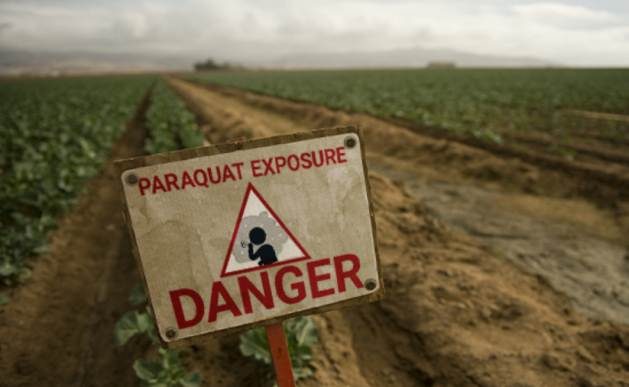Latino Farmworkers and People Living Near Farming Communities At High Risk of Developing Parkinsons — Global Issues
San Diego, California, US, Jun 22 (IPS) – The US agricultural industry has been one of the key sectors driving our country’s continuous demographic and economic growth. Unfortunately, farmworkers are one of the least protected professional groups, with minority and migrant agricultural laborers suffering disproportionately higher health risks due to deeply-entrenched discriminatory policies and practices.
Although acknowledged as essential workers during the height of the covid pandemic, minority farmworkers still have to contend with inadequate working conditions and insufficient social protections that leave them and their communities vulnerable to the enduring effects of toxic agrochemicals.
Rooted in Environmental Racism
Throughout the 20th century, redlining kept low-income ethnic communities segregated in areas with substandard living conditions. At the same time, racist lending practices enabled white Americans to operate and own 94 to 98 percent of US farmland, further preventing the social mobility of marginalized groups and their capacity to amass generational wealth.
The disproportionate health burdens minorities endure due to systemic prejudice is better described as “environmental racism.” Notably, approximately 83% of the US agricultural labor force is Hispanic. In rural areas where agriculture is the primary source of employment, this phenomenon is propagated by the excessive use of synthetic pesticides.
As the main ingredient in popular products like Gramoxone and Parazone, paraquat (paraquat dichloride) is an extremely effective herbicide used to combat weed species that have developed resistance to conventional pest-control chemicals. In the US, it’s labeled as a restricted-use substance, meaning that farmworkers are still allowed to spray it on crops as long as they receive proper EPA training and certification.
However, due to its high potency and increasing medical evidence indicating its links to life-threatening conditions, paraquat is currently banned in over 67 countries, including China, the EU, and Brazil.
Farmworker’s Toxic Exposure Risks
According to data from the US Geologic Survey, more than 17 million pounds of paraquat are used in US agriculture every year, with states like California, Texas, Illinois, and Mississippi spraying over 1 million pounds on crops annually. Other states where annual paraquat applications exceed 500,000 pounds/year include Tennessee, Oklahoma, Ohio, Arkansas, Louisiana, North Carolina, Missouri, South Dakota, Iowa, and Washington.
In California’s mainly-Hispanic counties, minority farmworkers and agricultural communities endure disproportionate levels of pesticide exposure. Although not exclusive to the Golden State, with similarly high rates documented in Florida, North Carolina, Idaho, and Washington, clinical studies carried out in the Central Valley illustrate the toxic burdens plaguing Latino and migrant workers.
Chronic exposure to paraquat has been linked to breast and thyroid cancer, as well as fetal and pregnancy-related toxicity. Even more concerning, a recent UCLA study found that long-term paraquat exposure is associated with higher Parkinson’s disease prevalence, building on evidence uncovered over a decade ago. Even though correlation doesn’t imply causation, it’s worth noting that California also has the highest number of Parkinson’s diagnoses in the US (106,701).
The steep health toll minority farmworkers and their families pay is punctuated not only by the lacking occupational protections that current pesticide regulations provide but also by farm owners’ disregard for EPA-mandated worker protection standards. While owners are obliged to provide safety training, personal protective equipment, and prevent workers’ access to fields until exposure risks subside, they rarely follow regulations given the low chance of penalties and insufficient institutional enforcement.
Additionally, the linguistic barriers migrant and minority farmworkers encounter make it less likely that they will fully understand safety guidelines or seek medical help when pesticide poisoning occurs. At the same time, non-English speakers who aren’t aware of their rights are far more susceptible to unscrupulous employers’ exploitative practices.
Combating Social Injustice in the Agricultural Sector
Despite the risks, ethnic farmworkers put up with unsafe working conditions and hesitate voicing their discontent since doing so may endanger their employment status and prevent them from earning the income their families rely on.
Faced with a plethora of socio-economic and occupational hazards, vulnerable minority workers and their communities rely on state and federal institutions to create a legal framework that provides adequate protection against toxic environmental exposure. However, the EPA controversially approved paraquat’s relicensing until 2035, discounting mounting evidence of the herbicide’s potential for enduring harm.
Several environmental, public health, and farmworkers’ rights organizations contested the EPA’s decision, determining the Agency to reconsider paraquat’s relicensing for agricultural purposes, with a final decision expected later this year. Such actions are vital and embolden disenfranchised minority groups who often lack the resources or political influence to confront industry interest groups who oppose pesticide policy reform.
Moving forward, Congress could help reduce exposure risks in the agricultural industry by restoring partial or complete jurisdiction over pesticide regulations to the Occupational Safety and Health Administration (OSHA), enabling better coordination with the EPA on regulatory and enforcement issues. Meanwhile, more attention should be afforded to legislative proposals such as Sen. Corry Booker’s Protect America’s Children from Toxic Pesticides Act (PACTPA), which seeks to ban dangerous pesticides like paraquat, impose more stringent penalties on uncompliant farm owners, and mandate bilingual labeling for pesticides.
Farmworkers who have worked with Paraquat pesticide either as a sprayer, chemical mixter, tank filler and have been diagnosed witth Parkinsons’ should file a Paraquat claim to obtain rightful compensation. People living near farming communities where Paraquat was sprayed and were diagnosed with Parkinson’s are also eligible for a claim.
Miguel Leyva is a case manager with Atraxia Law and helps agricultural workers harmed by Paraquat exposure compile the documentation and medical records needed to file a toxic exposure claim.
© Inter Press Service (2023) — All Rights ReservedOriginal source: Inter Press Service
Check out our Latest News and Follow us at Facebook
Original Source






